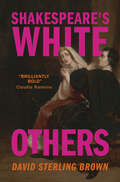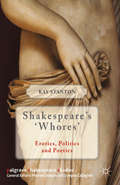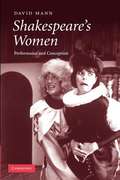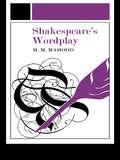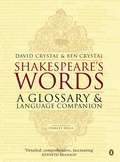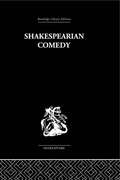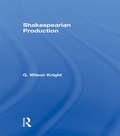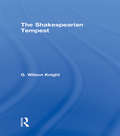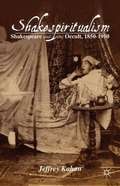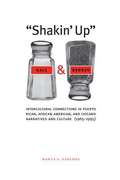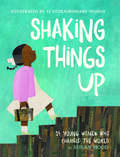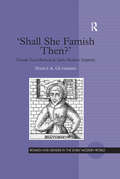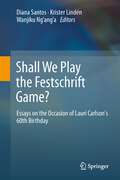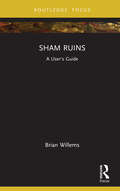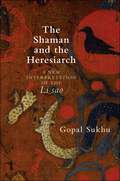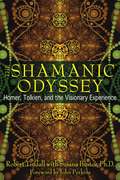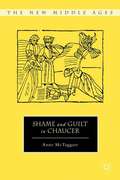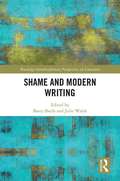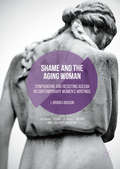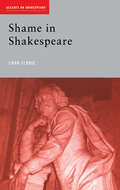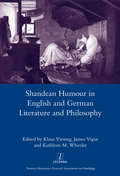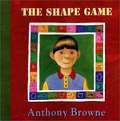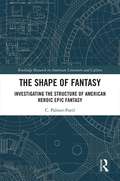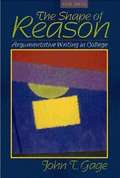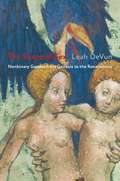- Table View
- List View
Shakespeare's White Others
by David Sterling BrownExamining the racially white 'others' whom Shakespeare creates in characters like Richard III, Hamlet and Tamora – figures who are never quite 'white enough' – this bold and compelling work emphasises how such classification perpetuates anti-Blackness and re-affirms white supremacy. David Sterling Brown offers nothing less here than a wholesale deconstruction of whiteness in Shakespeare's plays, arguing that the 'white other' was a racialized category already in formation during the Elizabethan era – and also one to which Shakespeare was himself a crucial contributor. In exploring Shakespeare's determinative role and strategic investment in identity politics (while drawing powerfully on his own life experiences, including adolescence), the author argues that even as Shakespearean theatrical texts functioned as engines of white identity formation, they expose the illusion of white racial solidarity. This essential contribution to Shakespeare studies, critical whiteness studies and critical race studies is an authoritative, urgent dismantling of dramatized racial profiling.
Shakespeare’s ‘Whores’
by Kay StantonShakespeare's 'Whores' studies each use of the word 'whore' in Shakespeare's canon, focusing especially on the positive personal and social effects of female sexuality, as represented in several major female characters, from the goddess Venus, to the queen Cleopatra, to the cross-dressing Rosalind, and many others.
Shakespeare's Women: Performance and Conception
by David MannDavid Mann examines the influence of the Elizabethan cross-dressed tradition on the performance and conception of Shakespeare's female roles through an analysis of all 205 extant plays written for the adult theater. The study provides both an historical context, showing how performance practice developed in the era before Shakespeare, and a comparative one, in revealing how dramatists in general treated their female characters and the influence their characterization had upon Shakespeare's writing. The book challenges many views of the sexual ethos of Elizabethan theater, offering instead a picture of Shakespeare which pays less attention to his supposed gender politics and more to his ability to exploit the cross-dressed convention as a dramatic medium. By challenging the gay and polemical feminist accounts that currently dominate the treatment of Elizabethan cross-dressing, the book restores its importance as a mainstream performance topic for academics and students.
Shakespeare's Wordplay
by M. M. Mahood`Professor Mahood's book has established itself as a classic in the field, not so much because of the ingenuity with which she reads Shakespeare's quibbles, but because her elucidation of pun and wordplay is intelligently related both to textual
Shakespeare's Words: A Glossary and Language Companion (Canto Classics Ser.)
by Ben Crystal David CrystalA vital resource for scholars, students and actors, this book contains glosses and quotes for over 14,000 words that could be misunderstood by or are unknown to a modern audience. Displayed panels look at such areas of Shakespeare's language as greetings, swear-words and terms of address. Plot summaries are included for all Shakespeare's plays and on the facing page is a unique diagramatic representation of the relationships within each play.
Shakespearian Comedy
by H. B. CharltonFirst published in 1938. This is a survey of Shakepeare's comedies which illustrates the playwright's increasing grasp on the art and idea of comedy. Themes, characters and plays covered include: Romanticism in Shakespearian comedy; Shakespeare's Jew, Falstaff, The Taming of the Shrew, A Midsummer Night's Dream, and The Dark Comedies.
Shakespearian Production V 6: With Especial Reference To The Tragedies
by G. Wilson KnightThis part of the G. Wilson Knight collected works, Volume VI looks at his view on Shakespearian production with special reference to the Tragedies.
Shakespearian Tempest - V 2
by G. Wilsin KnightFirst published in 2002. Routledge is an imprint of Taylor & Francis, an informa company.
Shakespiritualism
by Jeffrey KahanThis study concerns itself with a now-forgotten religious group, Spiritualists, and how their ensuing discussions of Shakespeare's meaning, his writing practices, his possible collaborations, and the supposed purity and/or corruption of his texts anticipated, accompanied, or silhouetted similar debates in Shakespeare Studies.
Shakin' Up Race and Gender: Intercultural Connections in Puerto Rican, African American, and Chicano Narratives and Culture (1965-1995)
by Marta Ester SánchezThe second phase of the civil rights movement (1965-1973) was a pivotal period in the development of ethnic groups in the United States. In the years since then, new generations have asked new questions to cast light on this watershed era. No longer is it productive to consider only the differences between ethnic groups; we must also study them in relation to one another and to U.S. mainstream society.<P><P>In "Shakin' Up" Race and Gender, Marta E. Sánchez creates an intercultural frame to study the historical and cultural connections among Puerto Ricans, African Americans, and Chicanos/as since the 1960s. Her frame opens up the black/white binary that dominated the 1960s and 1970s. It reveals the hidden yet real ties that connected ethnics of color and "white" ethnics in a shared intercultural history. By using key literary works published during this time, Sánchez reassesses and refutes the unflattering portrayals of ethnics by three leading intellectuals (Octavio Paz, Daniel Patrick Moynihan, and Oscar Lewis) who wrote about Chicanos, African Americans, and Puerto Ricans. She links their implicit misogyny to the trope of La Malinche from Chicano culture and shows how specific characteristics of this trope--enslavement, alleged betrayal, and cultural negotiation--are also present in African American and Puerto Rican cultures. Sánchez employs the trope to restore the agency denied to these groups. Intercultural contact--encounters between peoples of distinct ethnic groups--is the theme of this book.
Shaking Things Up: 14 Young Women Who Changed the World
by Susan Hood“Each poem and illustration shines with a personality all its own.” —Shelf Awareness (starred review)“This book has definitely made an impact on my life.” —Kitt Shapiro, daughter of Eartha KittFresh, accessible, and inspiring, Shaking Things Up introduces fourteen revolutionary young women—each paired with a noteworthy female artist—to the next generation of activists, trailblazers, and rabble-rousers.From the award-winning author of Ada’s Violin and Lifeboat 12, Susan Hood, this is a poetic and visual celebration of persistent women throughout history.In this book of poems, you will find Mary Anning, who was just thirteen when she unearthed a prehistoric fossil. You’ll meet Ruby Bridges, the brave six-year-old who helped end segregation in the South. And Maya Lin, who at twenty-one won a competition to create a war memorial, and then had to appear before Congress to defend her right to create.And those are just a few of the young women included in this book. Readers will also hear about Molly Williams, Annette Kellerman, Nellie Bly, Pura Belpré, Frida Kahlo, Jacqueline and Eileen Nearne, Frances Moore Lappé, Mae Jemison, Angela Zhang, and Malala Yousafzai—all whose stories will enthrall and inspire. This poetry collection was written, illustrated, edited, and designed by women and includes an author’s note, a timeline, and additional resources.With artwork by award-winning and bestselling artists including Selina Alko, Sophie Blackall, Lisa Brown, Hadley Hooper, Emily Winfield Martin, Oge Mora, Julie Morstad, Sara Palacios, LeUyen Pham, Erin Robinson, Isabel Roxas, Shadra Strickland, and Melissa Sweet.A 2019 Bank Street Best Book of the Year Named to the 2019 Texas Topaz Nonfiction Reading ListSelected for CCBC Choices Book 2019Selected as a Notable Social Studies Trade Books for Young People 2019Named to the Cuyahoga County Public Library’s 2018 list of Great Books for Kids2020-2021 South Carolina Picture Book Award Nominee
'Shall She Famish Then?': Female Food Refusal in Early Modern England (Women and Gender in the Early Modern World)
by Nancy A. GutierrezNancy Gutierrez's exploration of female food refusal during the early modern period contributes to the ongoing conversation about female subjectivity and agency in a number of ways. She joins such scholars as Gail Kern Paster, Jonathan Sawday, and Michael Schoenfeldt, who locate early modern ideas of selfhood in the age's understanding of the body and bodily functions, that is, the recognition that behavior and feelings are a result of the internal workings of the body. Exploring the portrayals of the anorectic woman in the work of Ford, Shakespeare, Heywood and others and arguing that the survival of these women undermines regulatory policies exercised over them by those in authority, Gutierrez here demonstrates how female food refusal is a unique demonstration of individuality. The chapters of this book reveal how the common cultural association of women and food manifests itself in the early modern period-not as religious expression, which is the medieval representation, and not as an expression of dysfunctional adolescence and maturation, our own contemporary view, but rather as a trope in which the female body is a site of political apprehension and cultural change. This study is neither a history nor a survey of the anorectic female body in early modern England, but rather individual yet related discussions in which the starved female body is seen to signify certain (un)expressed tensions within the culture.
Shall We Play the Festschrift Game?
by Krister Lindén Diana Santos Wanjiku Ng’ang’aThere are not many people who can be said to have influenced and impressed researchers in so many disparate areas and language-geographic fields as Lauri Carlson, as is evidenced in the present Festschrift. His insight and acute linguistic sensitivity and linguistic rationality have spawned findings and research work in many areas, from non-standard etymology to hardcore formal linguistics, not forgetting computational areas such as parsing, terminological databases, and, last but not least, machine translation. In addition to his renowned and widely acknowledged insights in tense and aspect and its relationship with nominal quantification, and his ground-breaking work in dialog using game-theoretic machinery, Lauri has in the last fifteen years as Professor of Language Theory and Translation Technology contributed immensely to areas such as translation, terminology and general applications of computational linguistics. The three editors of the present volume have successfully performed doctoral studies under Lauri's supervision, and wish with this volume to pay tribute to his supervision and to his influence in matters associated with research and scientific, linguistic and philosophical inquiry, as well as to his humanity and friendship.
Sham Ruins: A User's Guide (Routledge Focus on Literature)
by Brian WillemsIn the middle of the eigtheenth century, a new fad found its way into the gardens of England's well-to-do: building fake Gothic ruins. Newly constructed castle towers and walls looked like they were already falling apart, even on the first day of their creation. Made of stone, plaster, or even canvas, these "sham ruins" are often considered an embarrassing blip in English architectural history. However, Sham Ruins: A User's Guide expands the specific example of the sham ruin into a general principle to examine the way purposely broken objects can be used to both uncover old truths and invent new ones. Along with architecture, work by Ivan Vladislavić, Tom Stoppard, Alain Mabanckou, Aleksei Fedorchenko, Michael Haneke, and Sturtevant is used to develop this thesis, as well as artifacts such as pre-torn jeans, fake histories, and broken screen apps. Using these examples, one of the key questions the book raises is: what is it that sham ruins ruin? In other words, if real ruins are ruins of what they actually are, then sham ruins should be considered ruins of what they are not. Thus sham ruins are about imposing new meaning where such meaning does not and should not exist. They also can show how things we think are functioning well are actually already broken. Sham ruins do this, and much more, by being lies, ruses, and embarrassments. This is what gives them the power with which we can think about objects in new, unintended ways.
The Shaman and the Heresiarch: A New Interpretation of the Li sao (SUNY series in Chinese Philosophy and Culture)
by Gopal SukhuThe Li sao (also known as Encountering Sorrow), attributed to the poet-statesman Qu Yuan (4th–3rd century BCE), is one of the cornerstones of the Chinese poetic tradition. It has long been studied as China's first extended allegory in poetic form, yet most scholars agree that there is very little in the two-thousand-year-old tradition of commentary on it that convincingly explains its supernatural flights, its complex floral imagery, or the gender ambiguity of its primary poetic persona. The Shaman and the Heresiarch is the first book-length study of the Li sao in English, offering new translations of both the Li sao and the Nine Songs. The book traces the shortcomings of the earliest extant commentary on those texts, that of Wang Yi, back to the quasi-divinatory methods of the highly politicized tradition of Chinese classical hermeneutics in general, and the political machinations of a Han dynasty empress dowager in particular. It also offers an entirely new interpretation of the Li sao, one based not on Qu Yuan hagiography but on what late Warring States period artifacts and texts, including recently unearthed texts, teach us about the cultural context that produced the poem. In that light we see in the Li sao not only a reflection of the era of the great classical Chinese philosophers, but also the breakdown of the political-religious order of the ancient state of Chu.
The Shamanic Odyssey: Homer, Tolkien, and the Visionary Experience
by Robert Tindall Susana BustosReveals the striking parallels between indigenous cultures of the Americas and the ancient Homeric world as well as Tolkien’s Middle Earth • Explores the shamanic use of healing songs, psychoactive plants, and vision quests at the heart of the Odyssey and the fantasy works of J. R. R. Tolkien • Examines Odysseus’s encounters with plant divinities, altered consciousness, animal shapeshifting, and sacred topography--all concepts vital to shamanism • Reveals how the Odyssey emerged precisely at the rupture between modern and primal consciousness Indigenous, shamanic ways of healing and prophecy are not foreign to the West. The native way of viewing the world--that is, understanding our cosmos as living, sentient, and interconnected--can be found hidden throughout Western literature, beginning with the very origin of the European literary tradition: Homer’s Odyssey. Weaving together the narrative traditions of the ancient Greeks and Celts, the mythopoetic work of J. R. R. Tolkien, and the voices of plant medicine healers in North and South America, the authors explore the use of healing songs, psychoactive plants, and vision quests at the heart of the Odyssey, The Lord of the Rings trilogy, and Tolkien’s final novella, Smith of Wootton Major. The authors examine Odysseus’s encounters with plant divinities, altered consciousness, animal shapeshifting, and sacred topography--all concepts vital to shamanism. They show the deep affinities between the healing powers of ancient bardic song and the icaros of the shamans of the Amazon rain forest, how Odysseus’s battle with Circe--wielder of narcotic plants and Mistress of Animals--follows the traditional method of negotiating with a plant ally, and how Odysseus’s journey to the land of the dead signifies the universal practice of the vision quest, a key part of shamanic initiation. Emerging precisely at the rupture between modern and primal consciousness, Homer’s work represents a window into the lost native mind of the Western world. In this way, the Odyssey as well as Tolkien’s work can be seen as an awakening and healing song to return us to our native minds and bring our disconnected souls back into harmony with the living cosmos.
Shame and Guilt in Chaucer
by Anne MctaggartExplores the representation of emotions as psychological concepts and cultural constructs in Geoffrey Chaucer's narrative poetry. McTaggart argues that Chaucer's main works including The Canterbury Tales are united thematically in their positive view of guilt and in their anxiety about the desire for sacrifice and vengeance that shame can provoke.
Shame and Modern Writing (Routledge Interdisciplinary Perspectives on Literature)
by Barry Sheils Julie WalshShame and Modern Writing seeks to uncover the presence of shame in and across a vast array of modern writing modalities. This interdisciplinary volume includes essays from distinguished and emergent scholars in the Humanities and Social Sciences, and shorter practice-based reflections from poets and clinical writers. It serves as a timely reflection of shame as presented in modern writing, giving added attention to engagements on race, gender, and the question of new media representation.
Shame and the Aging Woman
by J. Brooks BousonThis book brings together the research findings of contemporary feminist age studies scholars, shame theorists, and feminist gerontologists in order to unfurl the affective dynamics of gendered ageism. In her analysis of what she calls "embodied shame," J. Brooks Bouson describes older women's shame about the visible signs of aging and the health and appearance of their bodies as they undergo the normal processes of bodily aging. Examining both fictional and nonfiction works by contemporary North American and British women authors, this book offers a sustained analysis of the various ways that ageism devalues and damages the identities of otherwise psychologically healthy women in our graying culture. Shame theory, as Bouson shows, astutely explains why gendered ageism is so deeply entrenched in our culture and why even aging feminists may succumb to this distressing, but sometimes hidden, cultural affliction.
Shame in Shakespeare (Accents on Shakespeare)
by Ewan FernieOne of the most intense and painful of our human passions, shame is typically seen in contemporary culture as a disability or a disease to be cured. Shakespeare's ultimately positive portrayal of the emotion challenges this view. Drawing on philosophers and theorists of shame, Shame in Shakespeare analyses the shame and humiliation suffered by the tragic hero, providing not only a new approach to Shakespeare but a committed and provocative argument for reclaiming shame.The volume provides:· an account of previous traditions of shame and of the Renaissance context· a thematic map of the rich manifestations of both masculine and feminine shame in Shakespeare· detailed readings of Hamlet, Othello, and King Lear· an analysis of the limitations of Roman shame in Antony and Cleopatra and Coriolanus· a polemical discussion of the fortunes of shame in modern literature after Shakespeare.The book presents a Shakespearean vision of shame as the way to the world outside the self. It establishes the continued vitality and relevance of Shakespeare and offers a fresh and exciting way of seeing his tragedies.
Shandean Humour in English and German Literature and Philosophy
by James Vigus"One of many writers inspired by Laurence Sterne's Tristram Shandy, the German novelist Jean Paul Richter coined the term 'Shandean humour' in his work of aesthetic theory. The essays in this volume investigate how Sterne's humour functions, the reasons for its enduring appeal, and what role it played in identity-construction and in the representation of melancholy. In tracing its hitherto under-recognised impact both on literary writers, such as Jean Paul and Herman Melville, and on philosophers, including Hegel and Marx, the collection reveals that Shandean humour is a Grenzganger - a point of commerce not only between Anglophone and German discourses, but also between literature and philosophy. Klaus Vieweg is Professor of Philosophy at the Friedrich Schiller University of Jena; James Vigus is postdoctoral research fellow at the Department of English and American Studies, Ludwig Maximilian University of Munich; Kathleen M. Wheeler is Reader in English Literature at the University of Cambridge."
The Shape Game
by Anthony BrowneThe author describes how his mother's wish to spend her birthday visiting an art museum with her family changed the course of his life forever.
The Shape of Fantasy: Investigating the Structure of American Heroic Epic Fantasy (Routledge Research in American Literature and Culture)
by Charul Palmer-PatelThe Shape of Fantasy is an in-depth look at Heroic Epic Fantasy. It depicts structural and narrative patterns with models stemming from science and philosophy. Although Fantasy Fiction is generally defined by its impossibility, Fantasy Fiction not an illogical form. It is, in fact, governed by a sense of rules and structure, one that reflects our current understanding of space-time and cosmology. These models are an integral part of the structure of Heroic Epic Fantasy itself. Thus, this book introduces new ways of perceiving current productions of the Fantasy genre. In doing so, it also explores how Fantasy Fiction exhibits a conscious awareness of its own form.
The Shape of Reason: Argumentative Writing in College
by John T. GageArgumentative reasoning addresses ideas that the writer takes seriously enough to want to explore and support with good reasons.
The Shape of Sex: Nonbinary Gender from Genesis to the Renaissance
by Leah DeVunThe Shape of Sex is a pathbreaking history of nonbinary sex, focusing on ideas and individuals who allegedly combined or crossed sex or gender categories from 200–1400 C.E. Ranging widely across premodern European thought and culture, Leah DeVun reveals how and why efforts to define “the human” so often hinged on ideas about nonbinary sex.The Shape of Sex examines a host of thinkers—theologians, cartographers, natural philosophers, lawyers, poets, surgeons, and alchemists—who used ideas about nonbinary sex as conceptual tools to order their political, cultural, and natural worlds. DeVun reconstructs the cultural landscape navigated by individuals whose sex or gender did not fit the binary alongside debates about animality, sexuality, race, religion, and human nature. The Shape of Sex charts an embrace of nonbinary sex in early Christianity, its brutal erasure at the turn of the thirteenth century, and a new enthusiasm for nonbinary transformations at the dawn of the Renaissance. Along the way, DeVun explores beliefs that Adam and Jesus were nonbinary-sexed; images of “monstrous races” in encyclopedias, maps, and illuminated manuscripts; justifications for violence against purportedly nonbinary outsiders such as Jews and Muslims; and the surgical “correction” of bodies that seemed to flout binary divisions.In a moment when questions about sex, gender, and identity have become incredibly urgent, The Shape of Sex casts new light on a complex and often contradictory past. It shows how premodern thinkers created a system of sex and embodiment that both anticipates and challenges modern beliefs about what it means to be male, female—and human.
